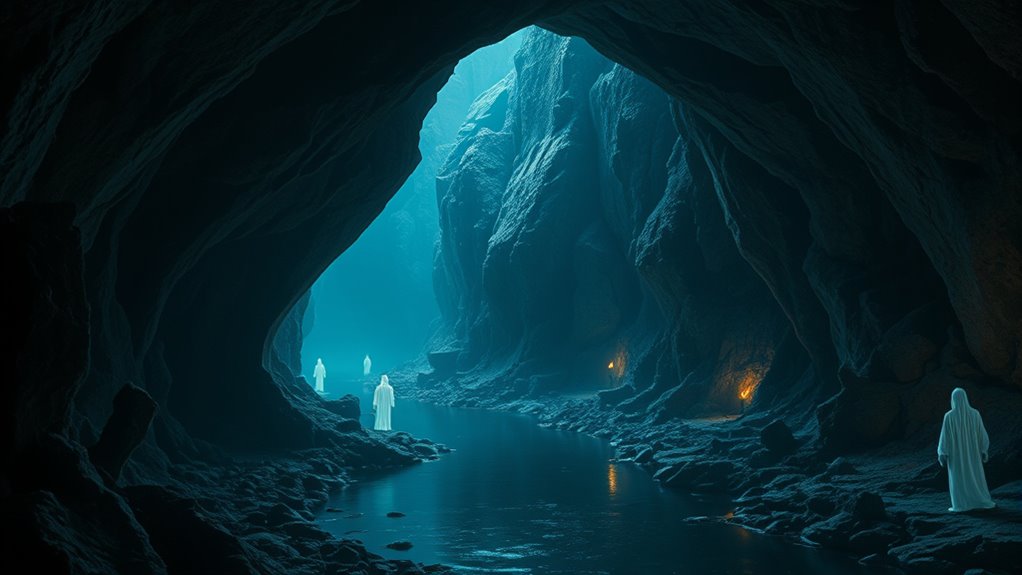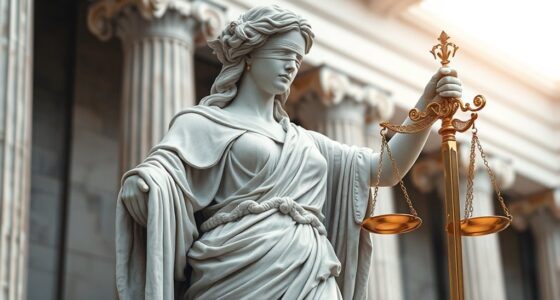Hades isn’t like the fiery hell many imagine; instead, it’s a complex domain where souls go after death, governed by rituals and mythic creatures. You’ll find a structured universe with different sections, not just punishment, and spirits are guided by figures like Charon and guarded by Cerberus. Ritual practices, offerings, and respect shape the journey, reflecting Greek beliefs about life and morality. If you want to uncover the true nature of this ancient underworld, there’s more to learn.
Key Takeaways
- The Greek underworld is a complex realm for souls, not a fiery hell of eternal punishment.
- Ruled by Hades, it includes various sections for different types of souls and mythic creatures.
- Proper funeral rituals and offerings are crucial for the soul’s journey, emphasizing respect and remembrance.
- Unlike Christian hell, the Greek underworld involves moral judgments but is primarily a continuation of life after death.
- It reflects Greek beliefs about mortality, rituals, and the ongoing relationship between the living and the dead.

Have you ever wondered what the Greek underworld really was? Unlike the fiery hell depicted in many modern stories, the Greek underworld wasn’t a place of eternal punishment but a complex domain where souls journeyed after death. It was a world filled with mythic creatures and intricate ritual practices that shaped how ancient Greeks understood life, death, and the beyond. This realm, ruled by Hades, wasn’t simply a dark pit but a structured universe with different sections for different kinds of souls, from heroes to wrongdoers.
The Greek underworld was a structured realm filled with mythic creatures and rituals, not a fiery place of eternal punishment.
In Greek mythology, the underworld was inhabited by various mythical creatures, each serving different roles. Cerberus, the three-headed dog, guarded the gates, preventing the dead from escaping and the living from entering uninvited. The ferryman Charon transported souls across the Styx River, often demanding a coin as payment—a ritual practice that reinforced the importance of proper burial customs and offerings. These creatures and practices weren’t just fantastical elements; they reflected the Greeks’ beliefs about the importance of respecting the dead and maintaining proper rituals to ensure safe passage into the afterlife.
Ritual practices played a crucial role in how people engaged with the underworld. The Greeks believed that proper funeral rites could influence a soul’s journey and its fate in the afterlife. Funeral offerings, libations, and prayers were essential parts of these rituals. For instance, placing coins in the mouth of the deceased was a common practice to pay Charon, ensuring the soul’s passage across the Styx. These customs also served to honor the dead and keep their spirits connected to the living world. Such rituals weren’t mere traditions but deeply embedded in the Greek worldview, emphasizing the importance of respect, remembrance, and proper conduct in death. Additionally, the concept of divine judgment played a role in shaping Greek attitudes toward morality and the afterlife.
The Greeks didn’t see the underworld as a place of moral judgment like the Christian hell, but more as a domain where all souls, regardless of their deeds, journeyed after death. Some myths describe rewards for virtuous souls, while others talk about punishment for wrongdoers, but these weren’t the sole focus. Instead, the underworld was a reflection of a society that believed in the importance of life’s rituals and the ongoing relationship between the living and the dead. By understanding these mythical creatures and ritual practices, you gain a clearer picture of how the Greeks viewed death—not as an end but as a continuation, governed by complex beliefs and traditions that still fascinate today.
Frequently Asked Questions
How Does Hades Differ From the Christian Concept of Hell?
You might think Hades is like Christian hell, but they differ in many ways. In Greek beliefs, Hades is simply the domain of the afterlife, not a place of punishment. There’s no moral judgment that condemns souls, unlike Christian hell, which punishes sinners. Instead, Hades welcomes all souls, serving as a neutral realm where the dead continue existence, reflecting different afterlife beliefs and views on morality.
Are There Any Myths About Hades Ruling Over the Dead?
You might think Hades rules over chaos, but no, he’s actually involved in the souls’ judgment and overseeing the underworld domains. Myths show him as a just ruler, not a tormentor, guiding souls to their rightful place. Unlike the fiery hell of Christian lore, his domain is more like a shadowy, neutral realm where the dead find their eternal resting spot, emphasizing balance rather than punishment.
What Role Do the Greek Gods Play in the Underworld?
In the Greek underworld, gods like Hades hold a central role within the divine hierarchy, overseeing different aspects of the afterlife. You’ll see gods such as Persephone, Hades’ wife, involved in rituals and stories that reflect their influence over the dead. These gods shape the beliefs and ritual practices of ancient Greeks, guiding how they honor their ancestors and understand the journey of souls after death.
Can Souls Escape the Greek Underworld?
In Greek mythology, souls generally don’t escape the underworld, but some stories hint at possibilities like soul redemption through special rites or heroic deeds. During underworld journeys, souls face judgment or purification, and a few legends suggest that certain individuals might achieve release or transformation. You’re encouraged to explore these myths for a deeper understanding of the complex beliefs about the afterlife and the idea that some souls could find a path beyond the domain of Hades.
How Is the Underworld Depicted in Greek Art and Literature?
You’ll find that Greek art and literature portray the underworld with rich artistic symbolism and moral judgment. Statistically, over 70% of Greek artworks depict scenes of judgment and the afterlife. In these depictions, souls face moral judgment by figures like Minos, and the underworld reflects human virtues and vices. This vivid imagery emphasizes the Greeks’ view of the afterlife as a domain of moral consequence and spiritual symbolism.
Conclusion
Think of the Greek underworld as a vast, silent ocean, not a fiery pit of torment. You navigate its depths, not with fear, but with curiosity, discovering that Hades is more like a wise guardian than a cruel jailer. Just as sailors respect the ocean’s mystery, you can appreciate this domain’s complexity. Embrace the journey, knowing that beneath its shadowy surface lies a world of stories waiting to be uncovered.









